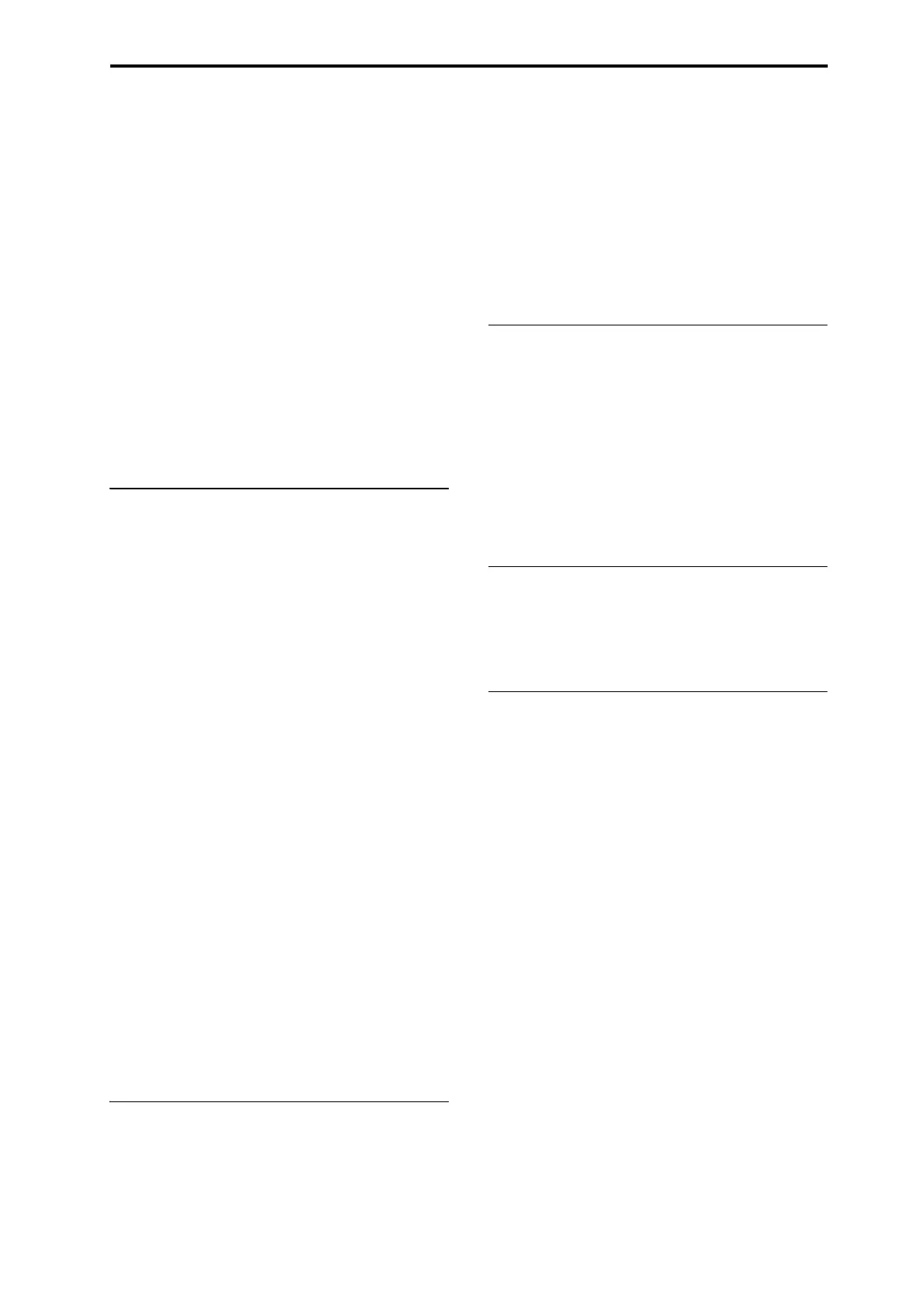MIDI applications Controlling Program tone & envelope shapes
317
MIDI instrument such as the KRONOS
Ribbon Controller (CC#16) [Bn, 10, vv]
When a control change is received from the ribbon controller or
other assigned controller of a MIDI instrument (such as the
KRONOS), the specified effect (e.g., alternate modulation or
dynamic modulation) will be applied.
• In Combination or Sequencer modes, transmission and
reception can be turned on/off for each timbre/track. (“Enable
Ribbon CC#16” on page 82, page 122)
Knob modulation 1–4 (CC#17, 19, 20, 21)
[Bn, 11, vv], [Bn, 13, vv], [Bn, 14, vv], [Bn, 15, vv]
When control changes assigned to the realtime control knobs of a
MIDI device such as the KRONOS are received, an effect such as
the assigned alternate modulation or dynamic modulation will be
applied.
Controller (CC#85, CC#86, CC#87, CC#88)
[Bn, 12, vv], [Bn, 13, vv], [Bn, 14, vv], [Bn, 15, vv]
When the VALUE dial of MIDI instruments such as the
KRONOS, or a control change assigned to a controller is received,
the specified alternate modulation or dynamic modulation effect
will be applied.
Controlling Program tone & envelope
shapes
CC#70–79 control specific parameters of a program.
For details on the program parameters that correspond to each
control change, and how the KROSS will respond in each mode
when these are received, refer to “KROSS and MIDI CCs” on
page 309.
Filter cutoff (CC#74) [Bn, 4A, vv]
Resonance level (CC#71) [Bn, 47, vv]
Attack time (CC#73) [Bn, 49, vv]
Release time (CC#72) [Bn, 48, vv]
Note: If TONE 1 or TONE 2 are selected in REALTIME
CONTROLS, these messages are respectively transmitted when
you operate the KNOB 1 knob or KNOB 2 knob.
Sustain level (CC#70) [Bn, 46, vv]
LFO 1 speed (CC#76) [Bn, 4C, vv]
LFO 1 depth (pitch) (CC#77) [Bn, 4D, vv]
LFO 1 delay (CC#78) [Bn, 4E, vv]
Filter EG intensity (CC#79) [Bn, 4F, vv]
When these are operated or received, the corresponding program
parameter is controlled, modifying the sound or the envelope.
(When the message has a value vv=64 [40], the setting will have
the value that was set by the program parameter.)
Note: In Program mode, the corresponding program parameters
will be temporarily edited by these messages. You can Write the
program to save the modified state (except for certain parameters).
The Write operation can also be performed by a MIDI System
Exclusive Program Write Request message, in addition to the
usual method of using the KROSS’s buttons. When you write the
data, the values of the corresponding program parameters will be
rewritten.
Note: The results of receiving these messages will depend on the
instrument. The operation may be different when a device other
than the KROSS is connected.
Arpeggiator control
If you assign a CC# to an arpeggiator parameter and use the
KROSS, that CC# will be transmitted and the KROSS will be
controlled. When that CC# is received, the same effect will be
applied as when the KROSS is used.
To use this, set the G-MIDI> OUT page ARP Controllers MIDI
Out setting to Control Change, and use the G-INPUT/CTRL> CC
page to specify the parameters.
Control changes can be assigned in the range of CC#000--119, but
normally you'll use the following default settings.
ARP ON/OFF (CC#14) [Bn, 0E, vv]
This corresponds to the ARP button. The transmitted value will be
vv=127[7F] when on, and vv=0 when off.
ARP GATE (CC#22) [Bn, 16, vv]
ARP VELOCITY (CC#23) [Bn, 17, vv]
ARP SWING (CC#24) [Bn, 18, vv]
These correspond to the ARP parameters. ARP GATE corresponds
to operations of the KNOB2 knob (ARP-GATE) when the
REALTIME CONTROLS section TEMPO row is selected.
Silencing all notes on a specific channel
All note off (CC#123) [Bn, 7B, 00] (value 00)
When this is received, all currently-sounding notes on that channel
will be turned off (as though the keys had been released).
However, the release portion of the notes will remain.
All sound off (CC#120) [Bn, 78, 00] (value 00)
When this is received, all currently-sounding notes on that channel
will be silenced. While the All Note Off message allows the
release portion of the notes to remain, the All Sound Off message
will silence the notes immediately.
However, these messages are provided for emergency use, and are
not something that you will use while performing.
Resetting all controllers on a specific
channel
Reset all controllers (CC#121) [Bn, 79, 00] (value 00)
When this is received, the value of all controllers on that channel
will be reset.
Using RPN (Registered Parameter
Numbers)
RPN (Registered Parameter Numbers) are a type of message that
allow settings to be made in a way that is common between
instrument manufacturers. (NRPN (Non-registered Parameter
Numbers) and exclusive messages can be freely used in non-
compatible ways by different manufacturers and models of
instrument.)
RPN messages can be used for editing with the following
procedure.
1. Use RPN MSB (CC#101) [Bn, 65, mm] and RPN LSB
(CC#100) [Bn, 64, rr] (n: channel, mm, rr: upper and lower
bytes of the parameter number) messages to select the
parameter.
2. Use data entry MSB (CC#6) [Bn, 06, mm] and data entry
LSB (CC#38) [Bn, 26, vv] (n: channel, mm, vv: upper and
lower bytes of the value, together expressing 16,384 levels)
to specify the value.
3. You can use data increment (CC#96) [Bn, 60, 00] or data
decrement (CC#97) [Bn, 61, 00] (n: channel, value is fixed
at 00) to change the value in steps of one.
The KROSS can receive the following three RPN messages
(tuning, transpose, and pitch bend range).
Tuning
RPN fine tune [Bn, 65, 00, 64, 01]
This RPN message can be used to adjust the detuning for a
program or timbre (in Combination mode), or for a track (in
Sequencer mode).
The procedure is as follows.
1. [Bn, 65, 00, 64, 01]: Select RPN parameter 01.

